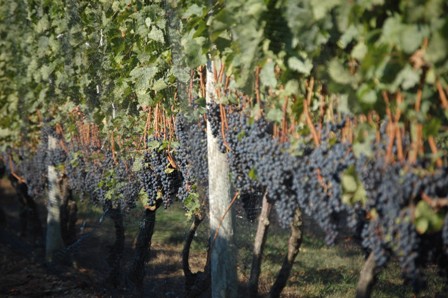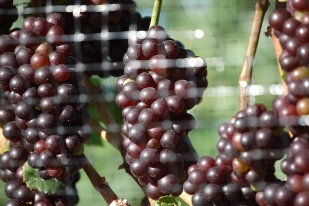|
Beaujolais Buy it Now and Buy it Often. Beaujolais red wine is the hottest wine going right now. The futures you purchase of this wine is poised to sky rocket in value, demand, and price. This is why I say buy it now and buy it often. This is no different than buying any other investment.

Beaujolais is a French Appellation d'Origine Contrôlée (AOC) wine generally made of the Gamay grape which has a thin skin and is low in tannins. Like most AOC wines they are not labeled varietally. Whites from the region, which make up only 1% of its production, are made mostly with Chardonnay grapes though Aligoté is also permitted. Beaujolais tends to be a very light-bodied red wine, with relatively high amounts of acidity. In some vintages, Beaujolais produces more wine than the Burgundy wine regions of Chablis, Côte d'Or, Côte Chalonnaise and Mâconnais put together. The wine takes its name from the historical Beaujolais province and wine producing region. It is located north of Lyon, and covers parts of the north of the Rhône département (Rhône-Alpes) and parts of the south of the Saône-et-Loire département (Burgundy). While administratively considered part of the Burgundy wine region, the climate is closer to the Rhône and the wine is unique enough to be considered separately from Burgundy and Rhône. The region is known internationally for its long tradition of winemaking, uniquely emphasized the use of carbonic maceration, and more recently for the popular Beaujolais nouveau.
The climate of Beaujolais is semi-continental with some temperate influences. The close proximately of the Mediterranean Sea does impart some Mediterranean influence on the climate. The region is overall, warmer than Burgundy with vintages more consistently ripening the grapes fully. By the time that the Beaujolais Nouveau is released in late November, the foothills in the western regions will have normally seen snow. A common viticultural hazard is spring time frost. The soils of Beaujolais divide the region into a northern and southern half, with the town of Villefranche serving as a near dividing point. The northern half of Beaujolais, where most of the Cru Beaujolais communes are located, includes rolling hills of schist and granite based soils with some limestone. On hillsides, most of the granite and schist is found in the upper slopes with the lower slopes having more stone and clay composition. The southern half of the region, also known as the Bas Beaujolais, has more flatter terrain with richer, sandstone and clay based soils with some limestone patches. The Gamay grape fares differently in both regions-producing more structured, complex wines in the north and more lighter, fruity wines in the south. The angle of the hillside vineyards in the north exposes the grapes to more sunshine which leads to harvest at an early time than the vineyards in the south.
Today, about a third of the region's production is sold as Beaujolais Nouveau, a marketing name created by George Duboeuf for the local vin de l'année. It is the lightest, fruitiest style of Beaujolais and meant for simple quaffing. Any Beaujolais or Beaujolais-Villages AOC vineyard can produce Beaujolais Nouveau. The grapes are harvested between late August and early September. It is fermented for just a few days and released to the public on the third Thursday of November - "Beaujolais Nouveau Day". It is the first French wine to be released for each vintage year. In 1992, at its peak, more than half of all Beaujolais wine was sold as "Beaujolais Nouveau". The wines are meant to be drunk as young as possible, when they are at their freshest and fruitiest. They can last up to one or two years but will have lost most of their characteristic flavors by that point.
The Gamay grape, more accurately known as Gamay Noir à Jus Blanc to distinguish it from the Gamay teinturier grapes with red juice and different from the Napa Gamay and the Gamay Beaujolais grapes of California, is the most widely planted grape in Beaujolais accounting for nearly 98% of all plantings. The remaining plantings are mostly Chardonnay. Aligote vines that were planted prior to 2004 are permitted in wine production but the entire grape variety is being phased out of the region by 2024. According to AOC regulation, up to 15% of white wine grape varieties can be included in all Beaujolais red wines from the basic Beaujolais AOC to the Cru Beaujolais wines but in practice the wines are almost always 100% Gamay. Pinot noir, which has very small plantings, is also permitted but that grape is being phased out by 2015 as Beaujolais winemakers continued to focus their winemaking identity on the Gamay grape. The characteristics that the Gamay grapes adds to Beaujolais is bluish-red deep color with low acidity, moderate tannins and light to medium body. The aromas associated with the grape itself is typically red berries. Since the 1960s, more focus has been placed on the choice of rootstocks and clonal selection with six approved clones of Gamay for the wine region. In recent years the rootstock Vialla has gained popularity due to its propensity to produce well in granite soils. The SO4 and 3309 rootstocks also account for significant plantings. Clonal selections of the Gamay grape has shifted towards an emphasis on smaller, thicker skinned berries.
After fermentation, the must is normally high in malic acid and producers will put the wine through malolactic fermentation to soften the wine. The process of chaptalization, adding sugar to the grape must to boost alcohol levels, has been a controversial issue for Beaujolais winemakers. Historically, Beaujolais producers would pick grapes at ripeness that were at minimum potential alcohol levels of 10-10.5% and then add sugar in order to artificially boost the alcohol levels to the near the maximum of 13-13.5%. This created wines that lack structure and balance to go with the high alcohol body and mouthfeel. The recent trend towards higher quality wine production has limited the use of chaptalization in the premium levels of Beaujolais wine. Filtering the wine, in order to stabilize it, is practiced to varying degrees by Beaujolais winemakers. Some producers who make Beaujolais on a large commercial scale will filter the wine aggressively, to avoid any impurity or future chemical reactions. This can have the negative side effect of diminishing some of the wines unique fruit character and leave a flavor that critics have described as Jell-O-like. Basic Beaujolais is the classic bistro wine of Paris; a fruity, easy-drinking red traditionally served in 1 pint glass bottles known as pot. This is epitomized in Beaujolais Nouveau, which is fermented for just a few days and can be dominated by estery flavors such as bananas and pear drops. Basic Beaujolais and Beaujolais nouveau are meant to be drunk within a year of their harvest. Beaujolais-Villages are generally consumed within 2–3 years and Cru Beaujolais has the potential to age longer, some not even fully developing till at least 3 years after harvest. Premium examples from Chénas, Juliénas, Morgon and Moulin-à-Vent can spend up to 10 years continuing to develop in the bottle and in very good vintages can take on Burgundian qualities of structure and complexity.
|
Sign up for weekly Red Wine Reviews
CLICK HEREWe will send you the extremely popular Red-Wine-Home tasting terms when you sign-up.






 Beaujolais wines are produced by the winemaking technique of semi-carbonic maceration. Whole grape clusters are put in cement or stainless steel tanks with capacities between 40-300 hectoliters (1,056 to 7,920 gallons). The bottom third of the grapes gets crushed under the weight of gravity and resulting must begins normal yeast fermentation with ambient yeasts found naturally on the skins of the grapes. Carbon dioxide is released as a by product of this fermentation and begins the saturate the individual, intact grape berries that remain in the barrel. The carbon dioxide seeps into the skin of the grape and begin to stimulate fermentation at an intracellular level. This is caused, in part, because of the absence of oxygen in the winemaking environment. This results in a fruity wine without much tannin. In the case of Beaujolais nouveau, this process is completed in as little as four days with the other AOCs being allowed longer time to ferment. As the grapes ferment longer, they develop more tannins and a fuller body.
Beaujolais wines are produced by the winemaking technique of semi-carbonic maceration. Whole grape clusters are put in cement or stainless steel tanks with capacities between 40-300 hectoliters (1,056 to 7,920 gallons). The bottom third of the grapes gets crushed under the weight of gravity and resulting must begins normal yeast fermentation with ambient yeasts found naturally on the skins of the grapes. Carbon dioxide is released as a by product of this fermentation and begins the saturate the individual, intact grape berries that remain in the barrel. The carbon dioxide seeps into the skin of the grape and begin to stimulate fermentation at an intracellular level. This is caused, in part, because of the absence of oxygen in the winemaking environment. This results in a fruity wine without much tannin. In the case of Beaujolais nouveau, this process is completed in as little as four days with the other AOCs being allowed longer time to ferment. As the grapes ferment longer, they develop more tannins and a fuller body.